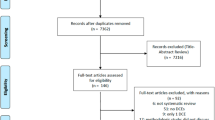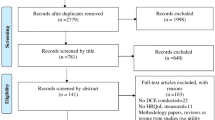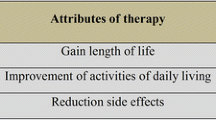Abstract
Stated-preference (SP) methods, such as discrete-choice experiments (DCE) and best–worst scaling (BWS), have increasingly been used to measure preferences for attributes of medical interventions. Preference information is commonly characterized using attribute importance. However, attribute importance measures can vary in value and interpretation depending on the method used to elicit preferences, the specific context of the questions, and the approach used to normalize attribute effects. This variation complicates the interpretation of preference results and the comparability of results across subgroups in a sample. This article highlights the potential consequences of ignoring variations in attribute importance measures, and makes the case for reporting more clearly how these measures are obtained and calculated. Transparency in the calculations can clarify what conclusions are supported by the results, and help make more accurate and meaningful comparisons across subsamples.

Similar content being viewed by others
Notes
Assuming the marginal utility of cost is constant.
This would be the omitted attribute in the case of dummy-coded variables.
Or the value of the omitted attribute in the case where dummy coding is used.
References
de Bekker-Grob EW, Ryan M, Gerard K. Discrete choice experiments in health economics: a review of the literature. Health Econ. 2012;21(2):145–72.
Clark MD, Determann D, Petrou S, Moro D, de Bekker-Grob EW. Discrete choice experiments in health economics: a review of the literature. Pharmacoeconomics. 2014;32(9):883–902.
Marshall D, Bridges JFP, Hauber B, Cameron R, Donnalley L, Fyie K, et al. Conjoint analysis applications in health—how are studies being designed and reported? Patient. 2010;3(4):249–56.
McFadden D. Conditional logit analysis of qualitative choice behavior. In: Zarembka P, editor. Frontiers in econometrics. New York: Academic; 1973.
Lancsar E, Louviere J, Donaldson C, Currie G, Burgess L. Best worst discrete choice experiments in health: methods and an application. Soc Sci Med. 2013;76:74–82.
Flynn TN, Louviere JJ, Peters TJ, Coast J. Best–worst scaling: what it can do for health care research and how to do it. J Health Econ. 2007;26(1):171–89.
Hauber AB, González JM, Groothuis-Oudshoorn CG, Prior T, Marshall DA, Cunningham C, et al. Statistical methods for the analysis of discrete choice experiments: a report of the ISPOR Conjoint Analysis Good Research Practices Task Force. Value Health. 2016;19(4):300–15.
Louviere JJ, Flynn TN, Marley AA. Best-worst scaling: theory, methods and applications. Cambridge: Cambridge University Press; 2015.
Johnson FR, Lancsar E, Marshall D, Kilambi V, Mühlbacher A, Regier DA, et al. Constructing experimental designs for discrete-choice experiments: report of the ISPOR conjoint analysis experimental design good research practices task force. Value Health. 2013;16(1):3–13.
Lancsar E, Louviere J, Flynn T. Several methods to investigate relative attribute impact in stated preference experiments. Soc Sci Med. 2007;64(8):1738–53.
Mühlbacher A, Johnson FR, Yang J-C, Happich M, Belger M. Do you want to hear the bad news? The value of diagnostic tests for Alzheimer’s disease. Value Health. 2016;19(1):66–74.
Okumura K, Inoue H, Yasaka M, Gonzalez JM, Hauber AB, Levitan B, et al. Comparing patient and physician risk tolerance for bleeding events associated with anticoagulants in atrial fibrillation—evidence from the United States and Japan. Value Health Reg Issues. 2015;6:65–72.
Hauber A, Arden N, Mohamed A, Johnson FR, Peloso P, Watson D, et al. A discrete-choice experiment of United Kingdom patients’ willingness to risk adverse events for improved function and pain control in osteoarthritis. Osteoarthritis Cartil. 2013;21(2):289–97.
Luyten J, Kessels R, Goos P, Beutels P. Public preferences for prioritizing preventive and curative health care interventions: a discrete choice experiment. Value Health. 2015;18(2):224–33.
Beusterien K, Middleton M, Feng Wang P, Rao S, Kotapati S, Sabater J, et al. Patient and physician preferences for treating adjuvant melanoma: a discrete choice experiment. J Cancer Ther. 2017;8:37–50.
Regier DA, Diorio C, Ethier M-C, Alli A, Alexander S, Boydell KM, et al. Discrete choice experiment to evaluate factors that influence preferences for antibiotic prophylaxis in pediatric oncology. PLoS One. 2012;7(10):e47470.
Yuan Z, Levitan B, Burton P, Poulos C, Brett Hauber A, Berlin JA. Relative importance of benefits and risks associated with antithrombotic therapies for acute coronary syndrome: patient and physician perspectives. Curr Med Res Opin. 2014;30(9):1733–41.
Mamounas E, Poulos C, Goertz H-P, González JM, Pugh A, Antao V. Neoadjuvant systemic therapy for breast cancer: factors influencing surgeons’ referrals. Ann Surg Oncol. 2016;23(11):3510–7.
Software Sawtooth. The MaxDiff system technical paper. Orem: Sawtooth Software, Inc.; 2013.
Acknowledgements
I would like to thank the anonymous reviewers for their many insightful comments and suggestions.
Author information
Authors and Affiliations
Corresponding author
Ethics declarations
Conflict of interest
Juan Marcos Gonzalez has no conflicts of interest that need to be disclosed.
Funding
The author received no specific funding for this work.
Rights and permissions
About this article
Cite this article
Gonzalez, J.M. A Guide to Measuring and Interpreting Attribute Importance. Patient 12, 287–295 (2019). https://doi.org/10.1007/s40271-019-00360-3
Published:
Issue Date:
DOI: https://doi.org/10.1007/s40271-019-00360-3




